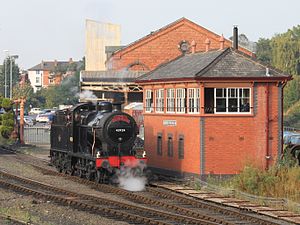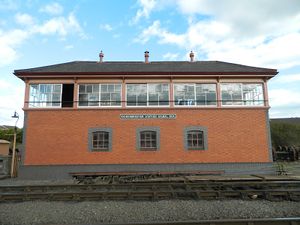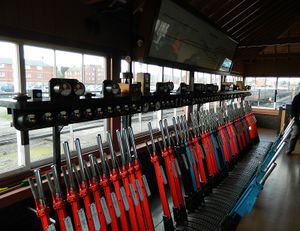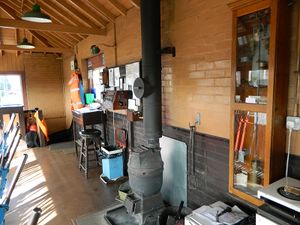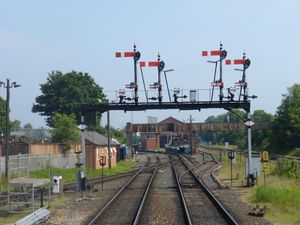Kidderminster Station signal box (1987 onwards)
Not to be confused with the original Kidderminster Station signal box (c.1873-1973), whose nameplate the current box bears.
A signal box at Kidderminster, working to Bewdley South. The box also communicates with Network Rail's West Midlands Signalling Centre (WMSC) at Saltley.
Contents
Construction
Kidderminster Town had no signal box when it opened in 1984, resulting in an 'only one engine in steam' restriction on operations which were controlled by a simple ground frame. The signal box was built between July and December 1986, the design being based on a typical GWR medium-sized box. Extensive measurements of Abbey Foregate and Sutton Bridge Junction signal boxes at Shrewsbury ensured authenticity. Installation of the signalling equipment took place throughout 1987. The installation work involved an estimated 8,000 man hours. producing a fully assembled 62 lever frame complete with all mechanical locking, fitting to the frame of 35 electric locks and 5 combined locks and circuit controllers, and installation of a 22 ft long block shelf complete with instruments. The box was commissioned on 21 November 1987[1] following installation of the most vital piece of equipment, the signalman’s leather armchair. The lever frame is a 5-bar vertical tappet frame of very late manufacture, being built in the late 1950s for Acton Yard signal box which had a short life. Evidence of its lateness may be found in the spring housing on the catch handle drop rods, which are of a much plainer hood design than previously used by the GWR/BR(W).
Signalling diagram
From 2020 the box will also control access to the Foley Park ground frame. How the signal box diagram will look once the ground frame has been installed:
Levers and Lever Leads
List of levers
| Nº. | Colour | Description | Lever Sequence |
|---|---|---|---|
| 1 | Red/Brown | Acceptance Lever from Bewdley south | |
| 2 | Red | Up Main Home | 17 13 |
| 3 | Red | Up Main to Nº1 Platform Inner Home | 17 35 |
| 4 | Red | Up Main to Nº1 Platform Calling On | 17 35 |
| 5 | Red | Up Main to Up loop Home | 29 14 13 |
| 6 | Red | Up Loop to Nº2 Platform Inner Home | 29 40 |
| 7 | Red | Up Loop to Nº2 Platform Calling On | 29 40 |
| 8 | Red | Up Loop to Nº1 Platform Inner Home | 30 29 35 |
| 9 | Red | Up Loop to Nº1 Platform Calling On | 30 29 35 |
| 10 | Red | Up Main to Exchange Line Inner Home | 19 17 |
| 11 | SPACE | ||
| 12 | SPACE | ||
| 13 | Red | Disc at 14 | |
| 14 | Black | Up Main Facing / Up Loop | |
| 15 | Red | Up Main to Engine Line Nº1 Inner Home (Disc) | 17 37 35 |
| 16 | Red | Up Main to Exchange Line Calling On | 19 17 |
| 17 | Blue | FPL for 18 | |
| 18 | Black | Up Main Facing / Exchange Line | |
| 19 | Black | Exchange Line Safety (Facing) | 18 |
| 20 | Blue | FPL For 19 | 19 |
| 21 | Red | Exchange Line to Down Main Starting (Disc) | 20 |
| 22 | SPACE | ||
| 23 | Red | From Carriage Shed Sidings Starting | 24 40 or 31 35 |
| 24 | Black | Up Loop / Carriage Shed Sidings | |
| 25 | Blue | FPL For 24A | |
| 26 | Red | Nº2 Platform to Carriage Shed Sidings Starting (Disc) | 24 25 |
| 27 | Red | Up Loop to Nº2 Engine Line Inner Home (Disc) | 29 42 40 |
| 28 | Red | Up Loop to Nº1 Engine Line Inner Home (Disc) | 37 30 29 35 |
| 29 | Blue | FPL for 30B | |
| 30 | Black | Up Loop & Down Main Facings / To Cross | |
| 31 | Black | Compound Points in Up & Down Loop | 24 30 |
| 32 | Blue | FPL for 31A | |
| 33 | Blue | FPL for 30A | Nil or 30 32 |
| 34 | Yellow | Nº1 Platform to Carriage Shed Sidings Starting (Disc) | 31 33 |
| 35 | Red | Disc at 37B | 36 |
| 36 | Blue | FPL for 37B | |
| 37 | Black | Nº1 Platform Facing / Nº1 Engine Line | |
| 38 | Red | Disc for 37A | 33 37 |
| 39 | SPACE | ||
| 40 | Red | Disc at 42B | 41 |
| 41 | Blue | FPL for 42B | |
| 42 | Black | Nº2 Platform Facing / Nº2 Engine Line | |
| 43 | Red | Disc for 42a | 25 42 |
| 44 | Red | Spare | |
| 45 | Blue/Black | Nº2 Platform / Nº2 Engine Line | |
| 46 | Red | Disc at 45b | |
| 47 | Red | Carriage Works Siding to/from Exchange Line Shunt | 48 |
| 48 | Black | Carriage Works Sidings Derailers | |
| 49 | Blue/Brown | Interlocking Lever with WMSC for DR724 Points | |
| 50 | Red | From Network Rail to Exchange Line Shunt (Slot) | 49 |
| 51 | Blue | FPL for 52B | |
| 52 | Black | Nº1 Platform / Nº1 Engine Line | 51 |
| 53 | Red | Disc at 52B | |
| 54 | SPACE | ||
| 55 | SPACE | ||
| 56 | Red+White Band | Down Main Outer Advanced Starting | |
| 57 | Red | Down Loop to Down Main Advanced Starting | 14 |
| 58 | Red | Nº1 Platform to Down Loop Starting | 30 33 |
| 59 | Red | Nº2 Platform to Down Loop Starting | 25 |
| 60 | Red | Down Main Advanced Starting | |
| 61 | Red | From Network Rail To Down Main Home (Slot) | 21 49 |
| 62 | Red | Nº1 Platform to Down Main Starting | 33 |
Connection to Network Rail
Until 2012 Kidderminster Station Signal Box worked to Kidderminster Junction signal box, 'over the fence' and operated by BR, RailTrack and finally Network Rail. The connection between the SVR and national rail was somewhat limiting, requiring staff on the track for any movement between railways. This all changed when Kidderminster Junction signal box closed in 2012 (its lever frame was saved for spares by the SVR) and extensive work by Network Rail and SVR S&T technicians installed one of the most comprehensive connections between the national rail network and a private heritage railway in existence, with movements from the SVR onto the Down Main and movements from the Up & Down Mains onto Network Rail being completely locked and signalled movements overseen by the cooperative efforts of the SVR signalman and NR signaller at Saltley. This upgrade also saw the first non-GWR/BR(W) signal installed on the SVR, in the form of a colour light signal reading from the SVR's 'exchange' line onto the national network or into the SVR's North Star Carriage & Wagon Works. The colour light signal can be seen beyond Kidderminster Footbridge in the photograph below.
Signalling controlled from the box
All signals at Kidderminster excepting the colour light signal (see above) are of late GWR/BR(W) steel tubular post and enamel arm design. The large gantry originates from Taunton East, although the layout of signals upon it is quite different to how it was when it was there. Its re-erection at Kidderminster began in the spring of 1987; the foundations on which it sits required 20 tons of concrete.[2] Installation of signal wiring took place over the summer. The connections as far as the signal gantry were commissioned along with the signal box on 21 November 1987.[1]
A further signal gantry, ex-Radyr, is in storage for the platform end to replace the current collection of planted posts. It is intended this will follow the planned eventual track slewing in association with an extension of the platform[3].
As part of the 2012 resignalling of the network connection, the 'exchange line' (see diagram) was upgraded from a siding to a running line, requiring derailers to be installed on the three siding roads leading out of the North Star Carriage & Wagon Works, as there was insufficient space for a trap point. These are worked from a lever in the box, possibly the only example of worked derailers installed on a heritage railway. There are also levers to provide a 'slot' (release) to the Network Rail signaller to allow trains to proceed from Network Rail onto the SVR.
Signals 2, 5 and 56 are motor worked.
2013 fire
During the morning of Saturday 3 March 2013, the signal box suffered a small fire in the roof at the point where the stove flue passes through the ceiling. The signalman was able to leave the box without injury. A small section of the roof was destroyed, and there was some damage to the telephone system and the domestic wiring caused by the water used by the Fire Brigade, although the signalling equipment was largely unaffected. Kidderminster station was initially closed. Once access to the box was regained, the water was mopped up to prevent it falling into the frame room and its electrics. By 4pm the debris had been cleared and the roof made weather-proof with a plastic sheet supplied by Bewdley C&W Department. Rapid work by the S&T and PW departments then saw normal service resumed by commencement of operations on the following day.
Open days
The box is occasionally open for public visits during special events such as the Open House Weekend. Access is strictly controlled on such occasions as the box is reached by crossing the tracks from the platform.
See also
References
- ↑ 1.0 1.1 SVRsig.org.uk
- ↑ SVR News 83
- ↑ Adrian Hassell
